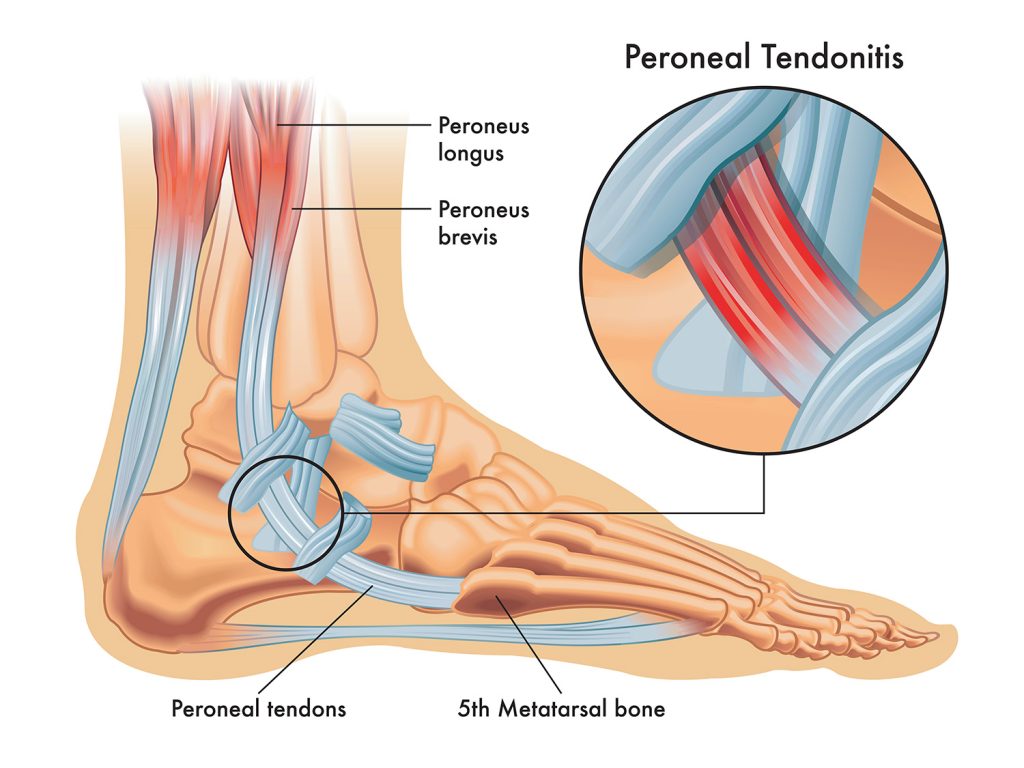Peroneal Tendonitis
What is Peroneal Tendonitis?

Peroneal tendonitis may be caused by functional ankle instability, trauma during a lateral ankle sprain, a subluxation (displacement) of the tendons, supinated foot posture, and bone or tendon abnormalities that decrease the space where the tendons pass. Repetitive motion and/or excessive loading cause’s inflammation and degradation of the tendons, resulting in lateral ankle/foot pain. Injuries to these tendons most commonly occur in athletes who participate in running and jumping activities.
How is Peroneal Tendonitis Diagnosed?
Subjective complaints that typically accompany this condition are a pain in the lateral aspect of the ankle/foot that worsens during activity and improves with rest, pain with walking or running, and feelings of imbalance.
Signs and Symptoms of Peroneal Tendonitis
- Swelling/warmth
- Popping, snapping or clicking sounds with movement
- Visible tendon subluxation (displacement)
- Pain along the posterior lateral aspect of the foot, along the muscle belly or tendon
- The peroneus brevis tendon will present with pain in the lateral and posterior aspect of the foot, approximately 2-3 cm distal to the lateral malleoli
- The peroneus longus tendon often occurs in the cuboid tunnel or where the muscle inserts on the base of the first metatarsal
- Weakness and/or pain with activation of peroneal muscles
- Pain with passive stretching of peroneal muscles
- Pain and possible difficulty with heel raises
- Instability with weight-bearing
How can a Physical Therapist Help with Peroneal Tendonitis?
Successful treatment is dependent on the cause of the peroneal tendonitis. If the cause of the inflammation is anatomical in nature (such as repetitive subluxation of the tendon), then surgery is recommended. However, if the cause is not strictly anatomical, then impairment-based treatment should be beneficial.
Physical Therapy treatment for peroneal tendonitis will include:
- Concentric and eccentric strengthening of the peroneal muscles
- Stretching the calf and peroneal muscles (After inflammation and pain have decreased)
- Proximal stabilization
- Functional weight-bearing exercises
- Ankle proprioception and balance training
- Therapeutic massage to peroneal muscles
- Modification of training load (Frequency, intensity, duration)
- Shoe wear evaluation
- Taping or temporary bracing if instability is present
Individuals who experience peroneal tendonitis usually recover fully, but it does take time and it is critical to avoid rushing back into activities too soon. If left untreated, peroneal tendonitis can result in degeneration and tearing, which can increase the chance of serious ankle sprains and/or nerve damage. Therefore, for optimal recovery, it is extremely important to seek treatment as soon as possible and adhere to the treatment plan that your physical therapist creates for you.





